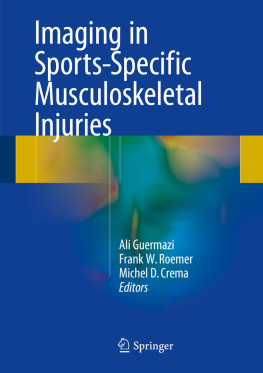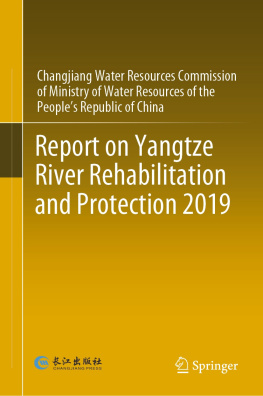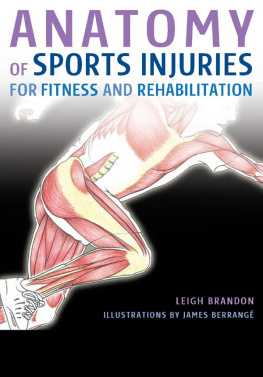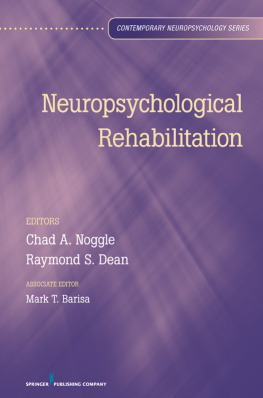Springer International Publishing Switzerland 2016
Ali Guermazi , Frank W. Roemer and Michel D. Crema (eds.) Imaging in Sports-Specific Musculoskeletal Injuries 10.1007/978-3-319-14307-1_1
1. What the Sports Medicine Physician Wants to Know from the Radiologist
Abstract
Sports medicine physicians may work in various areas of sports and medical care. In daily routine sports physicians face injured athletes who may present with acute musculoskeletal injuries, chronic injuries, or other organic problems that interfere with the athletes performance. Sports medicine physicians like any other clinician should rely on the patients history and clinical examination. However, a strong plea is made for sports medicine physicians and radiologists to combine their experience in clinical studies descriptive, diagnostic, and prospective which in the end will serve the athlete.
1.1 Introduction
Sports medicine physicians may work in various areas of sports and medical care. They can be found at high schools and colleges taking care of the school athletes at the college venue; they may be based in family medicine practice and have a special interest in athletic injuries; they may well work in dedicated sports medicine departments and hospitals; or they may be assigned to national/international level sporting clubs or federations. The common denominator for all these sports medicine doctors is that they will be confronted every time with injured athletes as a part of their job.
Based on their basic training, sports medicine physicians might be family physicians, pediatricians, orthopedic surgeons, general surgeons, or sports and exercise medicine specialists as in countries such as New Zealand, the United Kingdom, the Netherlands, and South Africa. Although they share the same basic training, their expertise and specialization have led them into different directions with varying amounts of experience with imaging techniques.
In daily routine sports physicians face injured athletes who may present with acute musculoskeletal injuries (e.g., sprains, strains, contusions, fractures), chronic injuries (e.g., tendinopathies, stress fractures, overuse injuries), or other organic problems that interfere with the athletes performance.
1.2 Clinical Examination
It can never be emphasized too much that sport physicians should focus on detailed history taking and a full physical examination of the injured athlete before thinking of imaging. In my opinion an experienced sports physician is capable of diagnosing 80 % of cases just by performing a careful history taking and a detailed clinical examination. Of course it is difficult to examine the freshly injured athlete coming from the field when there is muscle spasm and general physical defense because of pain and anxiety regarding the severity of the injury. Especially in elite sports and professional sports, there is huge pressure on the responsible physician to provide a diagnosis within several hours of the injury. It is not uncommon for the head of the medical staff to be asked by the media for an official medical statement as soon as the player has left the locker room. Although the quote additional investigations will tell us more about the injury may give the clinician some leeway, a differential diagnosis and clear direction to the radiologist will help the sports medicine physician, the athlete, and the radiologist. A huge benefit from clinical examination by the experienced sports medicine physician is the knowledge of musculoskeletal anatomy and the functional impairment of joints, muscles, and tendons. The clinical grading of a strain injury to the hamstring muscles can direct the radiologist to ultrasound or MRI grading of these injuries. In the best case scenario, the clinical grading and the radiological grading should match. On the other hand around 15 % of clinical strain injuries to the hamstring are not observed on ultrasound or MRI (Ekstrand et al. ).
1.3 Ligament Sprains
In clinical practice ligament sprains are diagnosed by the presumed injury mechanism, the amount of joint swelling and surrounding hematoma, and findings of instability. The fundamental role of the physician is to rule out accompanying (avulsion) fractures around the joint. The most common sprain in sports is the lateral ankle sprain. Based on the Ottawa ankle rules, the sports medicine physician can follow the algorithm to exclude a fracture by ordering an x-ray. Currently MRI is not widely used for assessing ankle ligament injuries, although concurrent injuries to the subchondral bone, the syndesmosis, or the medial ligament have been documented frequently (Chan et al. ). For sprains of the midfoot and forefoot, the wrist, the elbow, and the shoulder, sports medicine physicians can apply the same rules for requesting radiological investigations: rule out an avulsion fracture especially in juvenile athletes and adolescents and consider MRI in high-grade sprains for which surgical treatment may be indicated.
1.4 Fractures and Stress Fractures
Although sport physicians in the majority of cases deal with soft tissue injuries, they should still consider the use of conventional x-rays as a part of the routine workup in radiology. Ruling out fractures by x-ray and therefore changing the diagnosis, for instance, to a soft tissue contusion will have an important effect on the prognosis of the athletes injury. On the other hand waiting 23 days after a direct trauma for clinical symptoms to subside is common practice in sports medicine and will save unnecessary radiation. Stress fractures can be considered as the end stage of the continuum of soft tissue overload, failing response, trabecular overload, and cortical disruption. It is known that due to this continuum many stress fractures may have a long delay before presenting to the sports medicine physician. Initial presentation may mimic a soft tissue overload as primary x-rays will not always reveal bone abnormalities. Before the era of the MRI scan, the triple-phase bone scan (99mTc MDP scan) and CT scan were primarily used to diagnose stress fractures. Currently most sports medicine physicians and radiologists rely on the MRI scan to depict trabecular edema and peri-cortical edema to confirm a bone stress injury/stress fracture (Fredericson et al. ).
1.5 Tendinopathies
Tendinopathies and other soft tissue overload injuries may constitute 5060 % of clinical consultation time of the sports medicine physician. Tendinopathies can present as subacute pain following heavy load training or as chronic meandering pain for several weeks or months. Sports medicine physicians tend to grade tendinopathies based on their clinical presentation and the severity of complaints. Clinicians are well aware that acute tendinopathies respond favorably to rest from training, local ice application, and sometimes short prescription of NSAIDs. Depending on the setting, ultrasound scanning can be instrumental for documenting the pathology. Chronic tendinopathies however constitute a spectrum of pathology where additional investigations can cause more confusion to the athlete and the therapist regarding prognosis and outcome. Many studies have shown that abnormalities within the tendon as described on ultrasound or MRI have no or little association with clinical outcome (Cook and Purdam ). For that reason many clinicians do not rely on repetitive MRI or ultrasound scans during rehabilitation.








